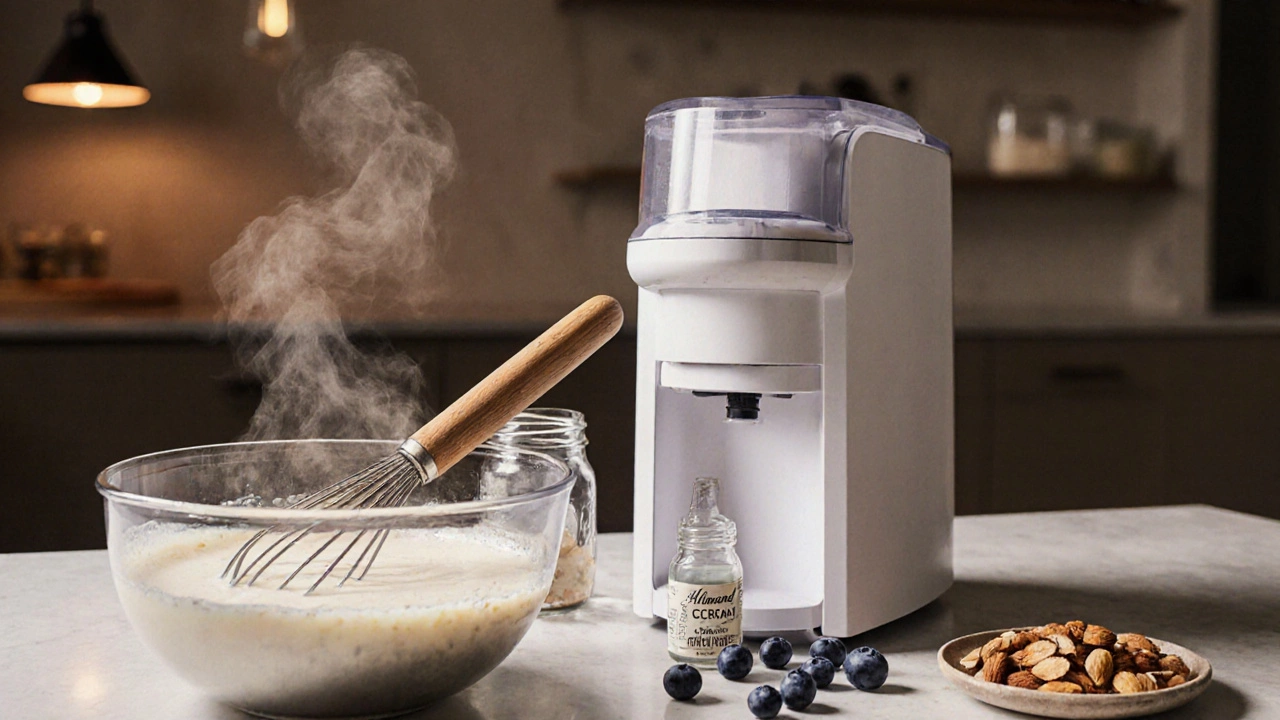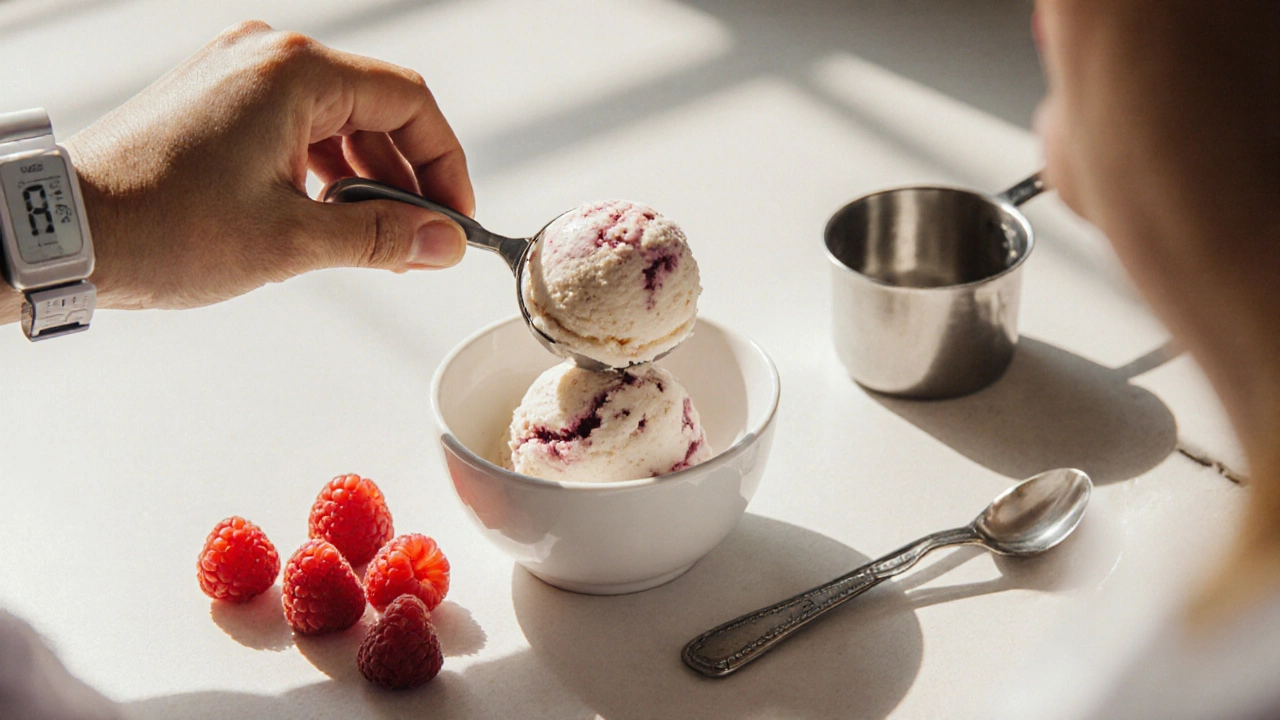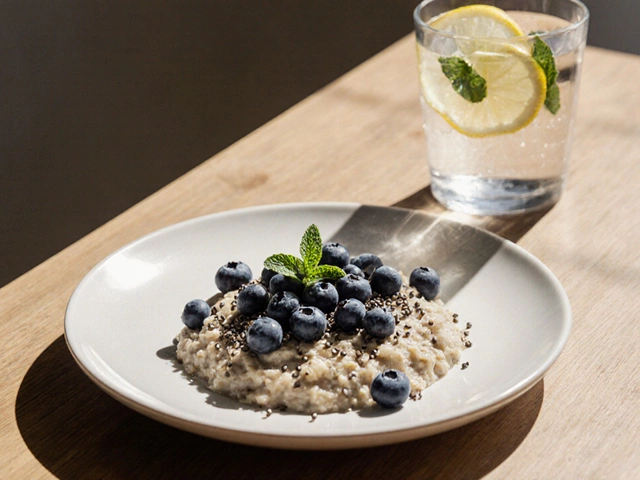Diabetes-Friendly Ice Cream Calculator
Calculate Net Carbs in Ice Cream
Enter the total carbohydrates and fiber content to calculate net carbs per serving.
Your Results
Diabetes-Friendly Guidelines
- 1Choose ice creams with net carbs under 10g per half-cup serving
- 2Look for natural sweeteners like stevia, erythritol, or monk fruit
- 3Avoid sugar alcohols like maltitol if sensitive to digestive issues
- 4Control portions with a half-cup measuring scoop
- 5Pair with protein or healthy fats to slow glucose absorption
When a sweet craving hits, many diabetics think ice cream is off‑limits. The good news? There are plenty of ice cream options that won’t send blood sugar spikes soaring, as long as you know what to look for and how to enjoy them responsibly.
Understanding the Basics
Ice cream is a frozen dessert made from dairy, sweeteners, and flavorings. Traditional recipes rely on sugar and full‑fat milk, which can raise glucose levels quickly. For people with diabetes, the key is to manage both the type of sweetener and the total carbohydrate load.
Two concepts matter most: glycemic index (how fast a food raises blood sugar) and net carbs (total carbs minus fiber). Choose ice creams with a low GI and low net carbs, and pair them with portion control strategies.
What Makes an Ice Cream Diabetic‑Friendly?
Look for these attributes:
- Sugar substitute that doesn’t spike insulin - examples include stevia, erythritol, or monk fruit.
- Low overall net carbs, usually under 10g per half‑cup serving.
- Higher protein or fat content helps blunt glucose spikes (but watch total calories).
- Clear labeling of total sugars versus added sugars.
Brands that meet these criteria often market themselves as “low‑carb,” “sugar‑free,” or “keto‑friendly.”
Common Sugar Substitutes and Their Impact
Not all substitutes are equal. Here’s a quick rundown:
- Stevia - a plant‑derived sweetener 200‑300 times sweeter than sugar, with zero calories and no effect on blood glucose.
- Erythritol - a sugar alcohol that provides about 0.24cal/g and is absorbed before reaching the colon, so it has a negligible glycemic impact.
- Monk fruit - another zero‑calorie sweetener, often blended with erythritol for texture.
- Artificial sweeteners (aspartame, sucralose) are safe for most diabetics, but some people prefer natural options.
When reading labels, watch for “sugar alcohols” like maltitol - they can cause digestive upset if consumed in large amounts.
Top Diabetes‑Friendly Ice Cream Brands (2025)
| Brand | Type | Net Carbs (g per ½cup) | Sweetener |
|---|---|---|---|
| Halo Top - Keto | Low‑carb | 5 | Erythritol + monk fruit |
| Enlightened - Sugar Free | Premium | 4 | Stevia + erythritol |
| Rebel Ice Cream | Keto | 2 | Allulose |
| Arctic Zero - Light | Low‑fat | 7 | Stevia |
| Lactaid - No‑Sugar | Lactose‑free | 6 | Sucralose |
All of the above keep net carbs under 10g per serving, making them safe choices for most diabetics. Remember to check the serving size - many brands list carbs for a half‑cup, but the typical scoop can be larger.
Homemade Diabetes‑Friendly Ice Cream
If you enjoy kitchen experiments, making your own ice cream lets you control every ingredient. Here’s a simple recipe that yields about four servings.
- Blend 2 cups of unsweetened almond milk, 1 cup of heavy cream, ½ cup of stevia (or ¼ cup erythritol), and 1 teaspoon of pure vanilla extract.
- Heat the mixture over medium heat until it just begins to steam (do not boil). This helps dissolve the sweetener.
- Cool the base in an ice bath, then chill in the refrigerator for at least 2hours.
- Churn in an ice‑cream maker according to the manufacturer’s instructions. If you don’t own one, pour the base into a shallow metal pan, freeze, and stir every 30minutes for 3‑4hours.
- Optional: fold in ¼ cup of chopped nuts or a handful of fresh berries for texture and extra nutrients.
The result is a smooth, diabetes friendly ice cream that typically contains under 6g net carbs per half‑cup. Adjust the sweetener to taste - remember it will taste sweeter after freezing.
Portion Control & Timing
Even low‑carb ice cream can affect blood glucose if you eat too much. Follow these practical tips:
- Measure a single portion (½cup) before you dig in. Using a small scoop helps keep servings consistent.
- Pair the serving with a source of protein or healthy fat - a few almonds, a slice of cheese, or a spoonful of nut butter can slow glucose absorption.
- Consume ice cream after a balanced meal rather than on an empty stomach. The mixed nutrients blunt the glycemic response.
- Monitor your blood sugar 30‑60minutes after eating. If the rise is larger than expected, reduce the portion next time.

Special Considerations for Different Diabetic Types
Type1 diabetes requires insulin dosing based on carbohydrate intake. Using a low‑carb ice cream can simplify bolus calculations - just count the net carbs for the measured portion.
Type2 diabetes often benefits from overall carbohydrate reduction. Choosing an ice cream with under 5g net carbs per serving can fit neatly into a low‑glycemic diet.
For both groups, individual tolerance varies. If you experience frequent spikes, consider swapping ice cream for a Greek yogurt parfait with berries and a sprinkle of low‑carb granola.
Frequently Asked Questions
Can regular ice cream be eaten in moderation?
Yes, if you track the carbs and adjust insulin or medication accordingly. A typical half‑cup of regular ice cream contains 15‑20g net carbs, which may fit within a larger meal plan if you offset it with lower‑carb foods.
Do sugar‑free ice creams contain hidden sugars?
Most reputable brands list “total sugars” and “added sugars” separately. Sugar‑free versions rely on non‑caloric sweeteners, so hidden sugars are rare. Always read the nutrition label for any added maltitol or dextrose.
Is lactose an issue for diabetics?
Lactose is a natural milk sugar that contributes to the total carbohydrate count. For people who are lactose intolerant, choosing lactose‑free ice cream removes that concern, but it still adds carbs unless a sugar substitute is used.
What’s the best sweetener for low glycemic impact?
Stevia and erythritol are top choices because they have a glycemic index of zero and are well‑tolerated at typical ice‑cream concentrations.
How often can I enjoy ice cream?
Frequency depends on your overall carbohydrate budget. Many diabetics fit a low‑carb scoop into their weekly plan a few times a month, especially when paired with protein and monitored with a glucose check.
Bottom Line
Ice cream doesn’t have to be a forbidden treat. By focusing on low‑net‑carb options, natural sweeteners like stevia or erythritol, and disciplined portion sizes, diabetics can savor a creamy dessert without compromising blood sugar control. Whether you pick a trusted brand or whip up a batch at home, the key is knowledge, labeling, and a little self‑monitoring.





